Computational Analysis of MHD Nonlinear Radiation Casson Hybrid Nanofluid Flow at Vertical Stretching Sheet
Abstract
:1. Introduction
2. Materials and Methods
- Unsteady flow of Casson hybrid nanofluid
- Stagnation point flow
- Thermal slip and nonlinear radiation
- MHD
- Vertical stretching sheet
| Thermophysical properties | |||
| 1600 | 2600 | 997.1 | |
| 3000 | 6600 | 0.613 | |
| 796 | 425 | 4179 |
Solution Procedure
3. Results and Discussion
4. Conclusions
- The temperature function () revealed to be declining due to improving the value of thermal slip (). Physically, the increment in thermal slip declined the surface drag leading to a decline in the production of heat amount which reduced the temperature distribution.
- The skin friction () and magnitude of temperature gradient () declined due to increment of thermal slip ().
- The skin friction () increased and temperature gradient () declined due to increment of solid nanoparticle concentration (). Physically, skin friction increased because of higher values of the solid nanoparticles, which increased resistance to the fluid motion.
- The curves of the temperature function () revealed declining due to improving the value of Casson fluid parameter ().
- The values of the nonlinear radiation parameter () increased which enhanced the curves of temperature function () due
- The skin friction () and magnitude of temperature gradient () declined due to increment of magnetic field parameter ().
- Yamada-Ota model of hybrid nanofluid achieved higher values as compared to Tiwari Das and Xue models of hybrid nanofluid.
Author Contributions
Funding
Informed Consent Statement
Data Availability Statement
Acknowledgments
Conflicts of Interest
Nomenclature
| Kinematic viscosity hybrid nanofluid | |
| Thermal conductivity of solid nanoparticle | |
| Thermal conductivity of solid nanoparticle | |
| Velocity components | |
| Stretching rate | |
| Kinematic viscosity fluid | |
| Free stream velocity | |
| Temperature function | |
| Velocity function | |
| Wall temeparature | |
| Ambient temperature | |
| Solid nanopartcile concentration | |
| Casson fluid parameter | |
| Solid nanopartcile concentration | |
| Heat capacity of solid nanoparticle | |
| Density of solid nanoparticle | |
| Thermal conductivity of hybrid nanofluid | |
| Thermal slip | |
| Prandtle number | |
| Unsteadyness parameter | |
| Density of fluid | |
| Heat capacity of solid nanoparticle | |
| Heat capacity of fluid | |
| Density of solid nanoparticle | |
| Thermal conductivity of fluid | |
| Radiation parameter | |
| Bouncy forces | |
| Magnetic field |
References
- Choi, S.U.; Eastman, J.A. Enhancing Thermal Conductivity of Fluids with Nanoparticles; No. ANL/MSD/CP-84938; CONF-951135-29; Argonne National Lab. (ANL): Argonne, IL, USA, 1995. [Google Scholar]
- Reddy, N.N.; Rao, V.S.; Reddy, B.R. Impact of thermal radiation and chemical reaction on MHD heat and mass transfer Casson nanofluid flow past a stretching sheet in presence of heat source/sink. ARPN J. Eng. Appl. Sci. 2006, 16, 1165–1172. [Google Scholar]
- Vajravelu, K.; Prasad, K.V.; Lee, J.; Lee, C.; Pop, I.; Van Gorder, R.A. Convective heat transfer in the flow of viscous Ag–water and Cu–water nanofluids over a stretching surface. Int. J. Therm. Sci. 2011, 50, 843–851. [Google Scholar] [CrossRef]
- Suresh, S.; Venkitaraj, K.P.; Selvakumar, P.; Chandrasekar, M. Effect of Al2O3–Cu/water hybrid nanofluid in heat transfer. Exp. Therm. Fluid Sci. 2012, 38, 54–60. [Google Scholar] [CrossRef]
- Suresh, S.; Venkitaraj, K.P.; Hameed, M.S.; Sarangan, J. Turbulent heat transfer and pressure drop characteristics of dilute water based Al2O3–Cu hybrid nanofluids. J. Nanosci. Nanotechnol. 2014, 14, 2563–2572. [Google Scholar] [CrossRef]
- Takabi, B.; Shokouhmand, H. Effects of Al2O3–Cu/water hybrid nanofluid on heat transfer and flow characteristics in turbulent regime. Int. J. Mod. Phys. C 2015, 26, 1550047. [Google Scholar] [CrossRef]
- Nadeem, S.; Abbas, N.; Khan, A.U. Characteristics of three dimensional stagnation point flow of Hybrid nanofluid past a circular cylinder. Results Phys. 2018, 8, 829–835. [Google Scholar] [CrossRef]
- Nadeem, S.; Abbas, N. On both MHD and slip effect in micropolar hybrid nanofluid past a circular cylinder under stagnation point region. Can. J. Phys. 2019, 97, 392–399. [Google Scholar] [CrossRef]
- Nadeem, S.; Abbas, N.; Malik, M.Y. Inspection of hybrid based nanofluid flow over a curved surface. Comput. Methods Programs Biomed. 2020, 189, 105193. [Google Scholar] [CrossRef]
- Abbas, N.; Nadeem, S.; Saleem, A.; Malik, M.Y.; Issakhov, A.; Alharbi, F.M. Models base study of inclined MHD of hybrid nanofluid flow over nonlinear stretching cylinder. Chin. J. Phys. 2021, 69, 109–117. [Google Scholar] [CrossRef]
- Abbas, N.; Rehman, K.U.; Shatanawi, W.; Malik, M.Y. Numerical study of heat transfer in hybrid nanofluid flow over permeable nonlinear stretching curved surface with thermal slip. Int. Commun. Heat Mass Transf. 2022, 135, 106107. [Google Scholar] [CrossRef]
- Li, P.; Duraihem, F.Z.; Awan, A.U.; Al-Zubaidi, A.; Abbas, N.; Ahmad, D. Heat Transfer of Hybrid Nanomaterials Base Maxwell Micropolar Fluid Flow over an Exponentially Stretching Surface. Nanomaterials 2022, 12, 1207. [Google Scholar] [CrossRef] [PubMed]
- Neethu, T.S.; Sabu, A.S.; Mathew, A.; Wakif, A.; Areekara, S. Multiple linear regression on bioconvective MHD hybrid nanofluid flow past an exponential stretching sheet with radiation and dissipation effects. Int. Commun. Heat Mass Transf. 2022, 135, 106115. [Google Scholar] [CrossRef]
- Casson, N. A Flow Equation for Pigment-Oil Suspensions of the Printing Ink Type. In Rheology of Disperse Systems; Pergamon Press: Oxford, UK, 1959. [Google Scholar]
- Abbas, N.; Shatanawi, W. Heat and Mass Transfer of Micropolar-Casson Nanofluid over Vertical Variable Stretching Riga Sheet. Energies 2022, 15, 4945. [Google Scholar] [CrossRef]
- Nadeem, S.; Haq, R.U.; Akbar, N.S. MHD three-dimensional boundary layer flow of Casson nanofluid past a linearly stretching sheet with convective boundary condition. IEEE Trans. Nanotechnol. 2013, 13, 109–115. [Google Scholar] [CrossRef]
- Oyelakin, I.S.; Mondal, S.; Sibanda, P. Unsteady Casson nanofluid flow over a stretching sheet with thermal radiation, convective and slip boundary conditions. Alex. Eng. J. 2016, 55, 1025–1035. [Google Scholar] [CrossRef] [Green Version]
- Ibrahim, S.M.; Lorenzini, G.; Kumar, P.V.; Raju, C.S.K. Influence of chemical reaction and heat source on dissipative MHD mixed convection flow of a Casson nanofluid over a nonlinear permeable stretching sheet. Int. J. Heat Mass Transf. 2017, 111, 346–355. [Google Scholar] [CrossRef]
- Amjad, M.; Zehra, I.; Nadeem, S.; Abbas, N.; Saleem, A.; Issakhov, A. Influence of Lorentz force and induced magnetic field effects on Casson micropolar nanofluid flow over a permeable curved stretching/shrinking surface under the stagnation region. Surf. Interfaces 2020, 21, 100766. [Google Scholar] [CrossRef]
- Lanjwani, H.B.; Saleem, S.; Chandio, M.S.; Anwar, M.I.; Abbas, N. Stability analysis of triple solutions of Casson nanofluid past on a vertical exponentially stretching/shrinking sheet. Adv. Mech. Eng. 2021, 13, 16878140211059679. [Google Scholar] [CrossRef]
- Tawade, J.V.; Guled, C.N.; Noeiaghdam, S.; Fernandez-Gamiz, U.; Govindan, V.; Balamuralitharan, S. Effects of thermophoresis and Brownian motion for thermal and chemically reacting Casson nanofluid flow over a linearly stretching sheet. Results Eng. 2022, 15, 100448. [Google Scholar] [CrossRef]
- Abbas, Z.; Imran, M.; Naveed, M. Impact of Equally Diffusive Chemical Reaction on Time-Dependent Flow of Casson Nanofluid Due to Oscillatory Curved Stretching Surface with Thermal Radiation. Arab. J. Sci. Eng. 2022, 1–20. Available online: https://link.springer.com/article/10.1007/s13369-022-06792-8 (accessed on 6 June 2022).
- Ramzan, M.; Gul, H.; Malik, M.Y.; Ghazwani, H.A.S. Entropy Minimization Analysis of a Partially Ionized Casson Nanofluid Flow over a Bidirectional Stretching Sheet with Surface Catalyzed Reaction. Arab. J. Sci. Eng. 2022, 1–13. Available online: https://link.springer.com/article/10.1007/s13369-021-06492-9 (accessed on 6 June 2022).
- Yang, K.T. Unsteady laminar boundary layers in an incompressible stagnation flow. J. Appl. Mech. 1958, 25, 421–427. [Google Scholar] [CrossRef]
- Wang, C.Y. Liquid film on an unsteady stretching surface. Q. Appl. Math. 1990, 48, 601–610. [Google Scholar] [CrossRef] [Green Version]
- Abbas, Z.; Hayat, T.; Sajid, M.; Asghar, S. Unsteady flow of a second grade fluid film over an unsteady stretching sheet. Math. Comput. Model. 2008, 48, 518–526. [Google Scholar] [CrossRef]
- Mabood, F.; Shateyi, S. Multiple slip effects on MHD unsteady flow heat and mass transfer impinging on permeable stretching sheet with radiation. Model. Simul. Eng. 2019, 2019, 3052790. [Google Scholar] [CrossRef] [Green Version]
- Fuzhang, W.; Anwar, M.I.; Ali, M.; El-Shafay, A.S.; Abbas, N.; Ali, R. Inspections of unsteady micropolar nanofluid model over exponentially stretching curved surface with chemical reaction. Waves Random Complex Media 2022, 1–22. [Google Scholar] [CrossRef]
- Abbas, N.; Nadeem, S.; Khan, M.N. Numerical analysis of unsteady magnetized micropolar fluid flow over a curved surface. J. Therm. Anal. Calorim. 2022, 147, 6449–6459. [Google Scholar] [CrossRef]
- Iqbal, Z.; Khan, M.; Shoaib, M.; Matoog, R.T.; Muhammad, T.; El-Zahar, E.R. Study of buoyancy effects in unsteady stagnation point flow of Maxwell nanofluid over a vertical stretching sheet in the presence of Joule heating. Waves Random Complex Media 2022, 1–15. [Google Scholar] [CrossRef]
- Yamada, E.; Ota, T. Effective thermal conductivity of dispersed materials. Wärme-Und Stoffübertragung 1980, 13, 27–37. [Google Scholar] [CrossRef]
- Xue, Q.Z. Model for thermal conductivity of carbon nanotube-based composites. Phys. B 2005, 368, 302–307. [Google Scholar] [CrossRef]
- Tiwari, R.K.; Das, M.K. Heat transfer augmentation in a two-sided lid-driven differentially heated square cavity utilizing nanofluids. Int. J. Heat Mass Transf. 2007, 50, 2002–2018. [Google Scholar] [CrossRef]
- Abbas, N.; Nadeem, S.; Malik, M.Y. On extended version of Yamada–Ota and Xue models in micropolar fluid flow under the region of stagnation point. Phys. A Stat. Mech. Its Appl. 2020, 542, 123512. [Google Scholar] [CrossRef]
- Abbas, N.; Malik, M.Y.; Nadeem, S.; Alarifi, I.M. On extended version of Yamada–Ota and Xue models of hybrid nanofluid on moving needle. Eur. Phys. J. Plus 2020, 135, 1–16. [Google Scholar] [CrossRef]
- Zingg, D.W.; Chisholm, T.T. Runge–Kutta methods for linear ordinary differential equations. Appl. Numer. Math. 1999, 31, 227–238. [Google Scholar] [CrossRef]
- Abbas, N.; Malik, M.Y.; Nadeem, S.; Hussain, S.; El-Shafa, A.S. Similarity solution of second grade fluid flow over a moving cylinder. Int. J. Mod. Phys. B 2021, 35, 2150325. [Google Scholar] [CrossRef]
- Wang, C.Y. Stagnation flow towards a shrinking sheet. Int. J. Non-Linear Mech. 2008, 43, 377–382. [Google Scholar] [CrossRef]
- Bachok, N.; Ishak, A.; Pop, I. Stagnation-point flow over a stretching/shrinking sheet in a nanofluid. Nanoscale Res. Lett. 2011, 6, 1–10. [Google Scholar] [CrossRef] [Green Version]


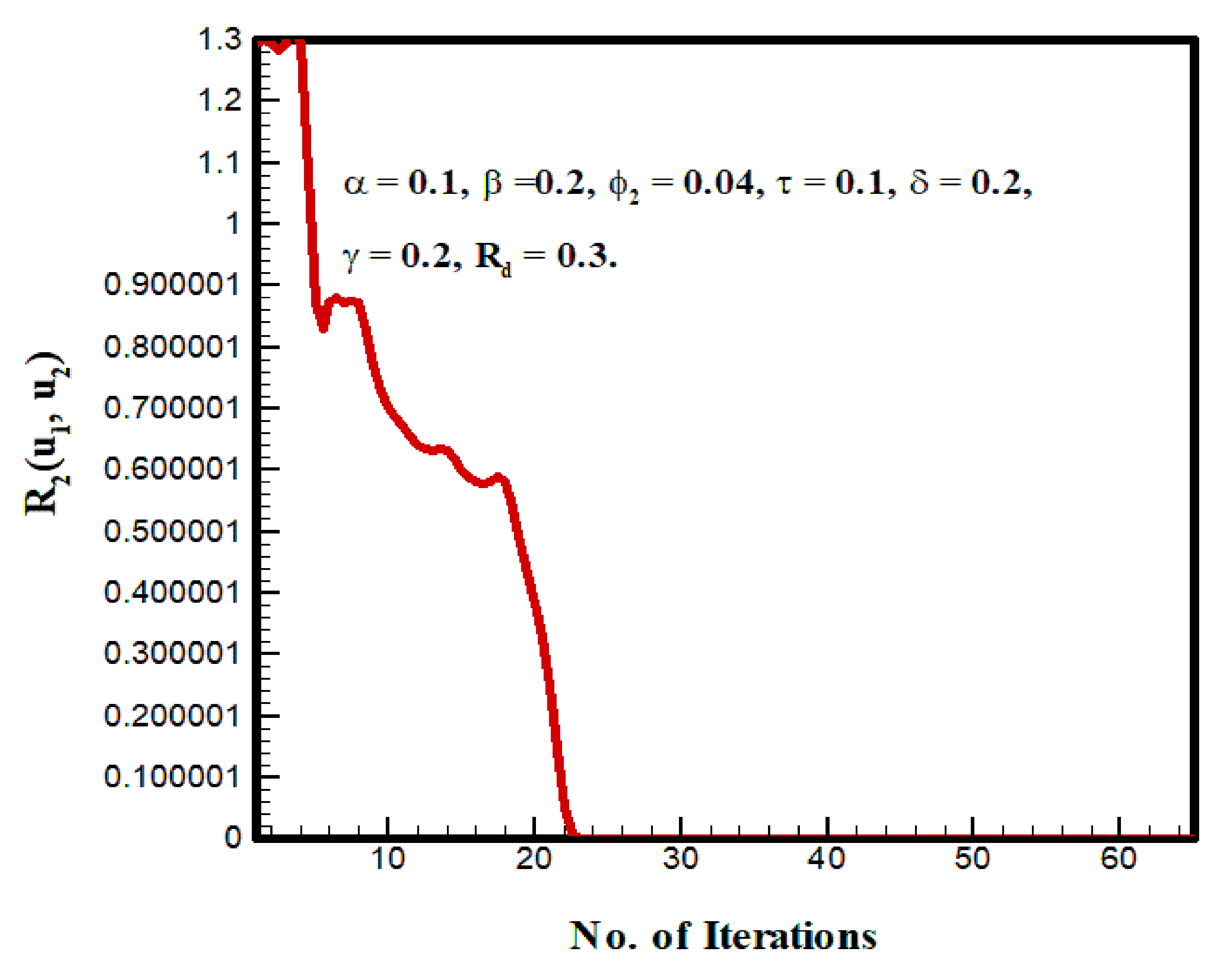
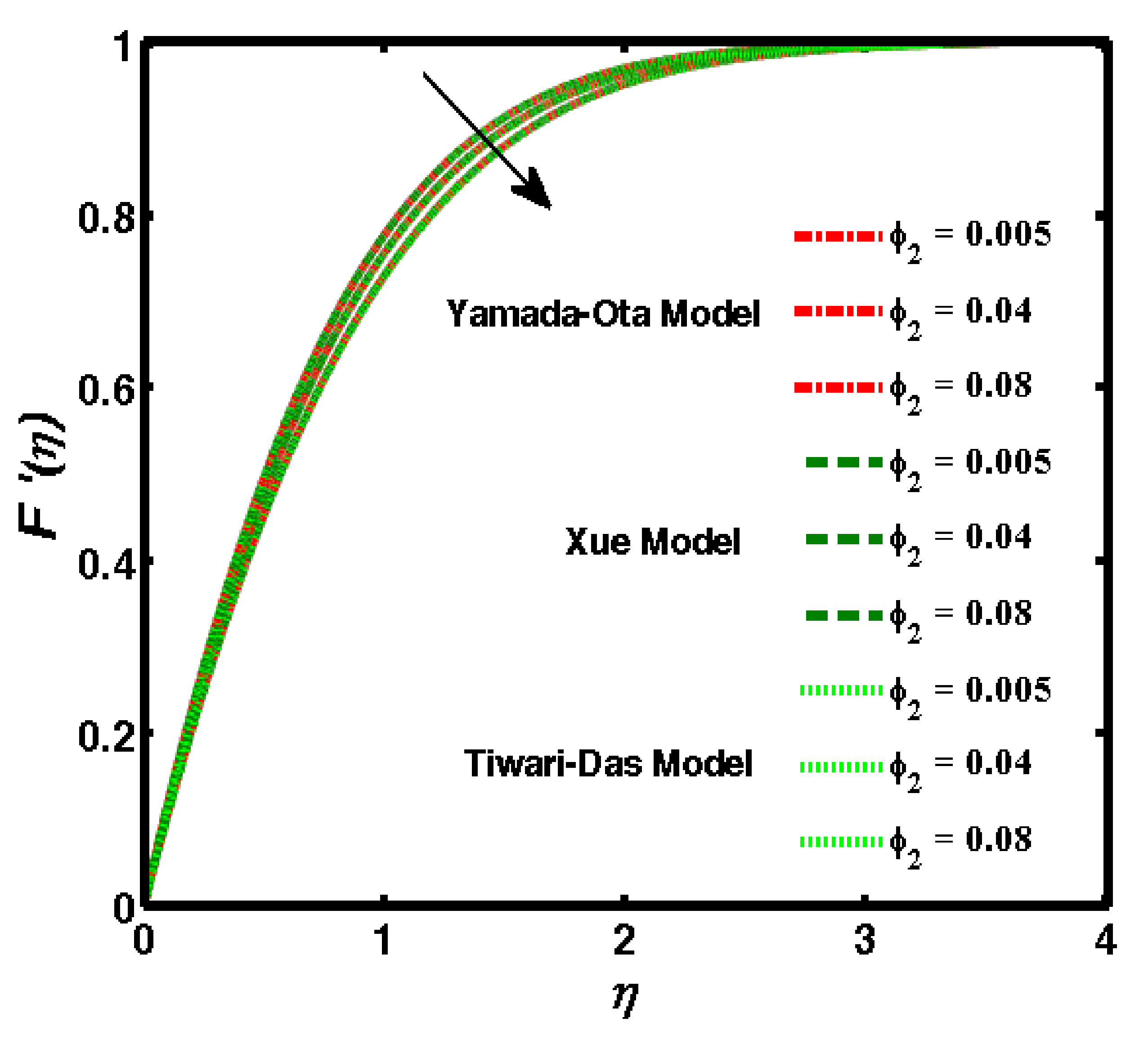

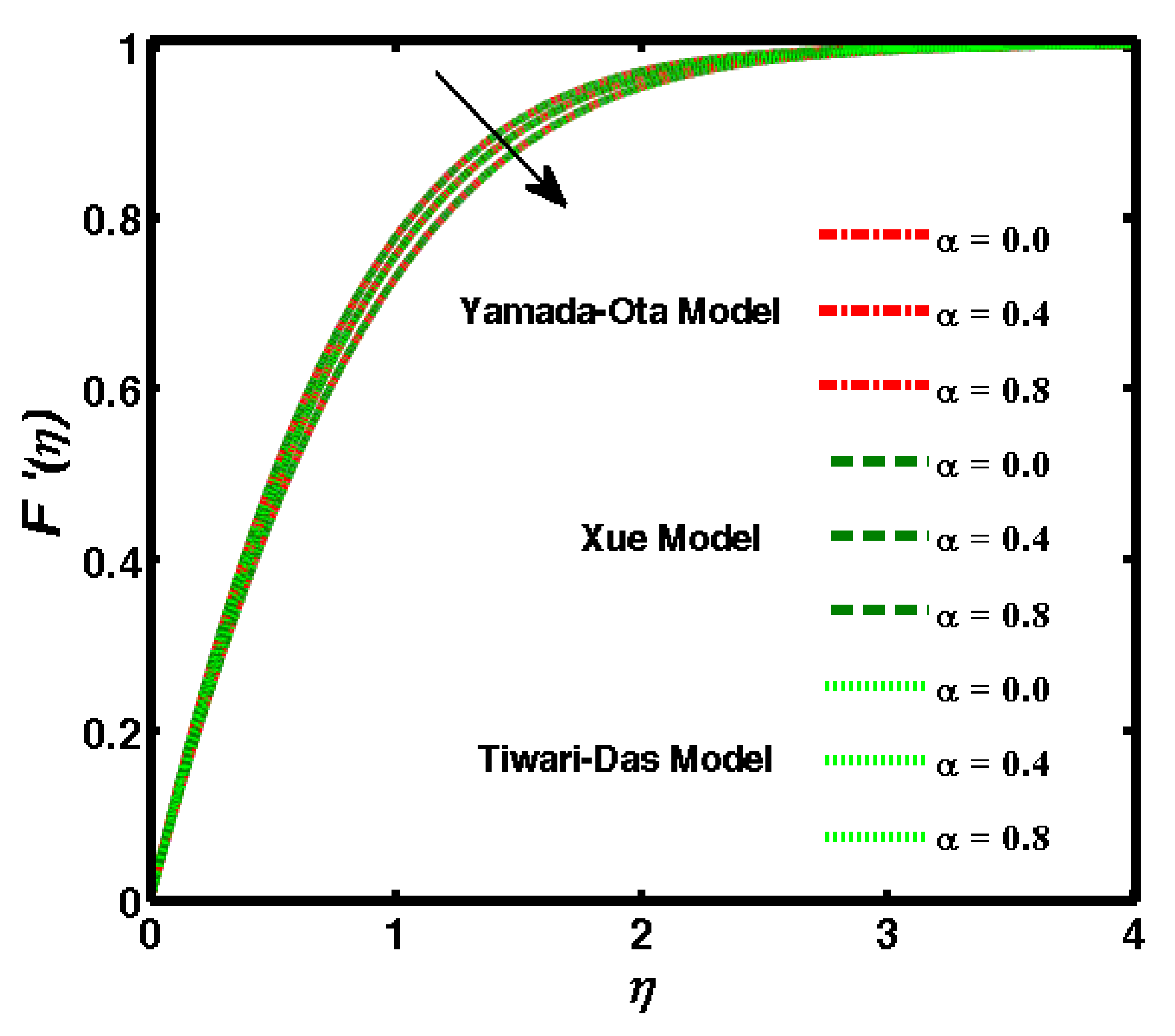
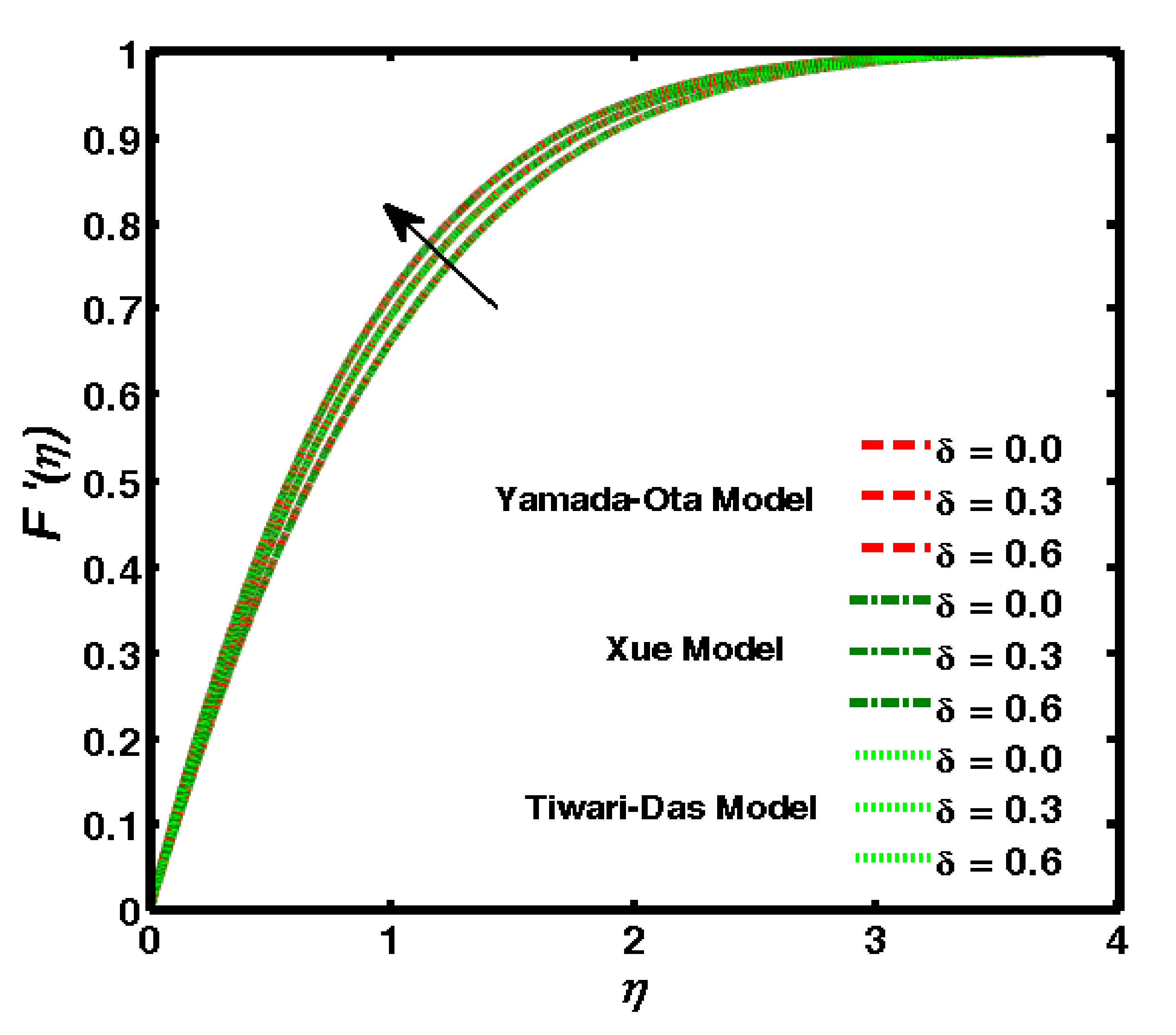
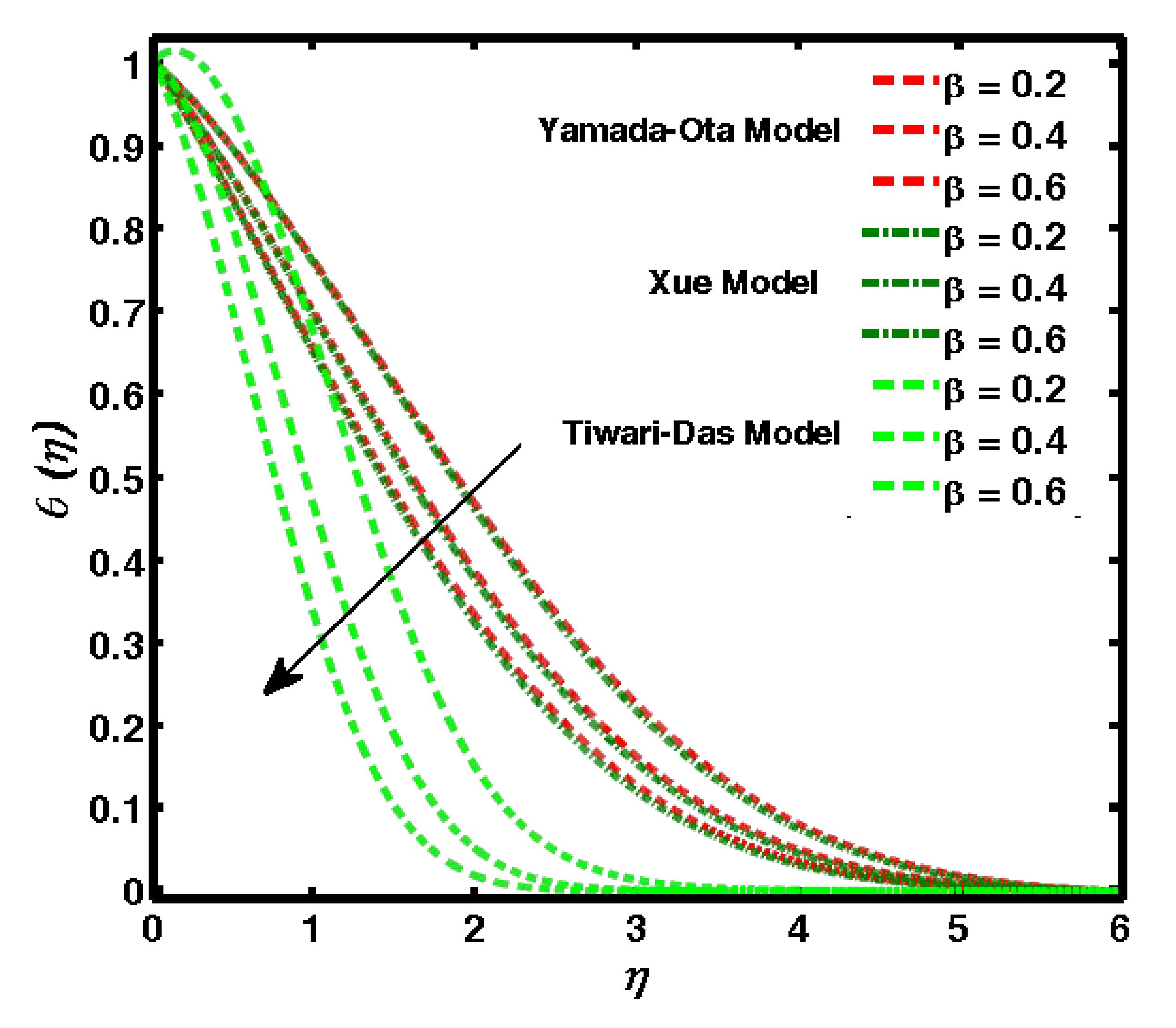
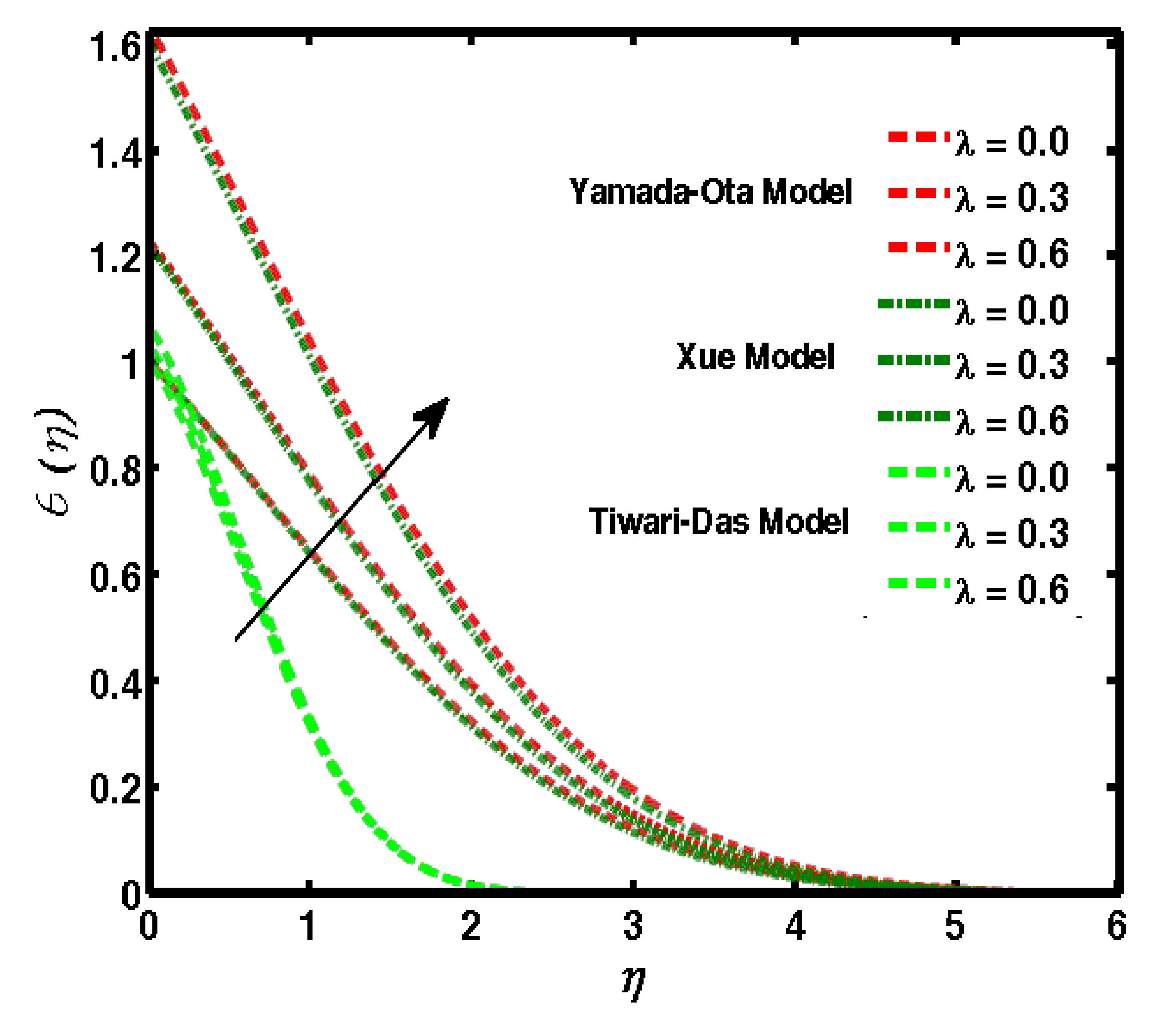

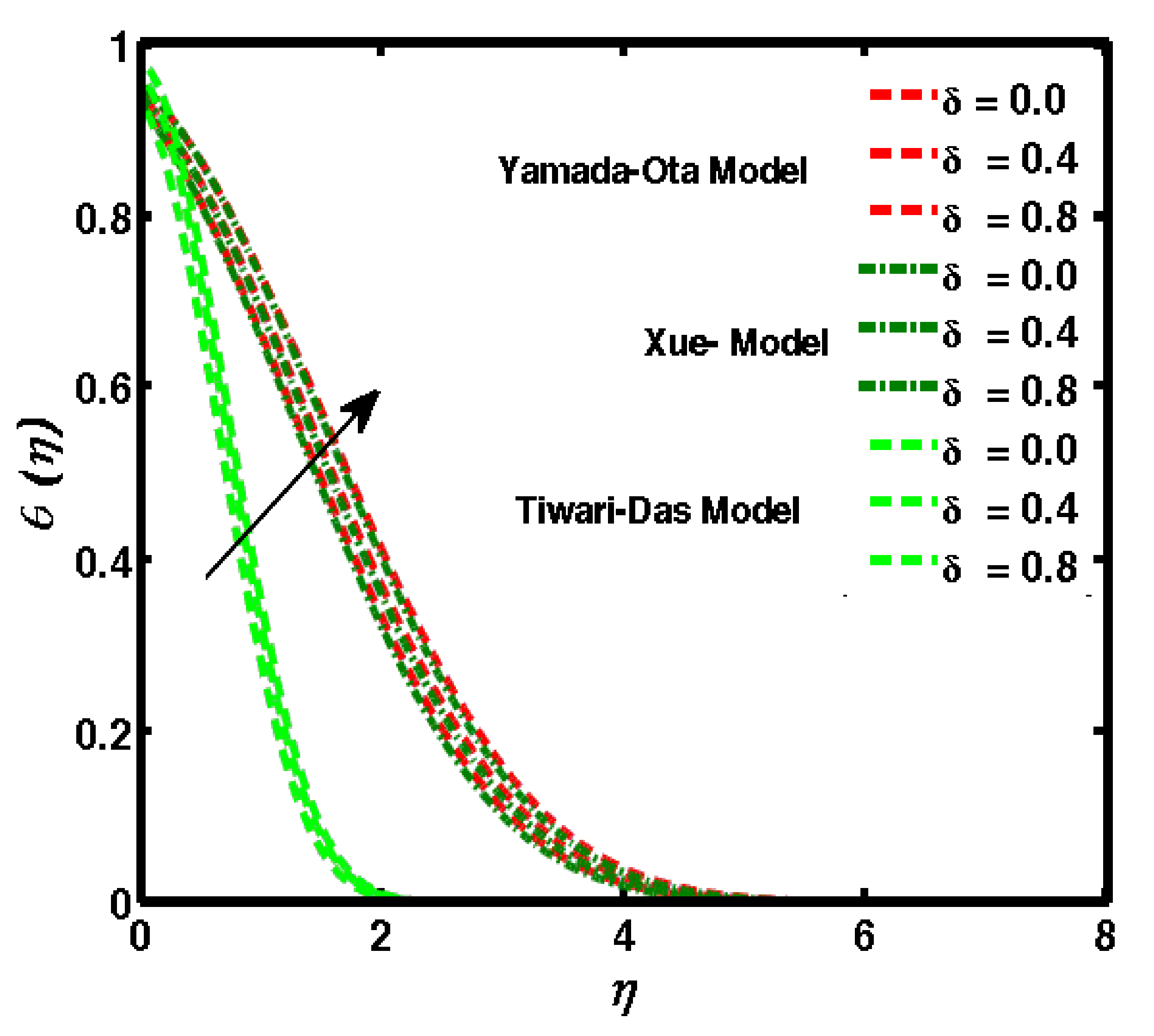
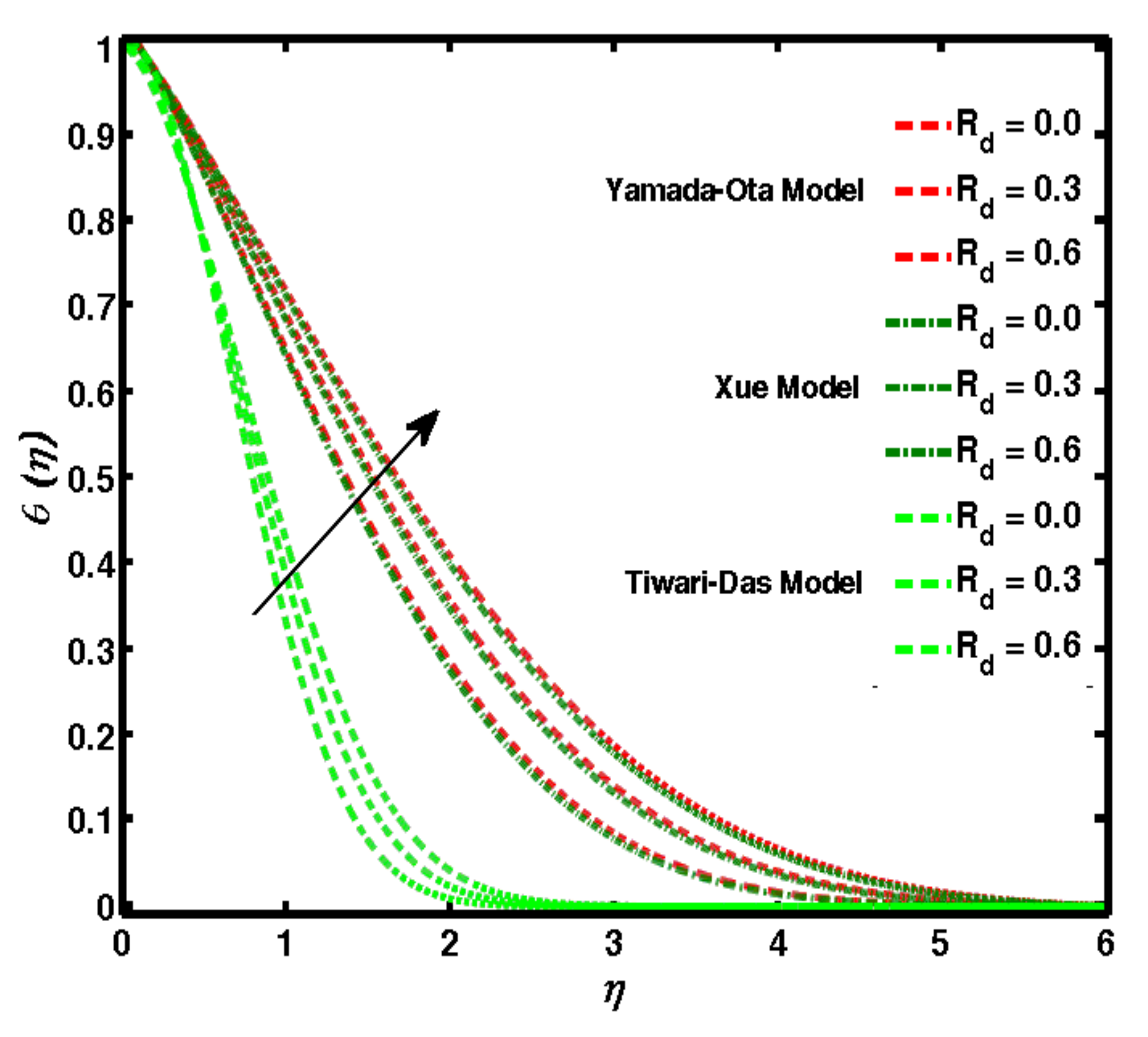

| 0.0 | 0.04 | 0.2 | 0.3 | 0.4 | 0.3 | 0.1 | 2.813517 | 0.064449 | 3.201124 | 0.06349211 | 2.952714 | 0.3956732 |
| 0.1 | - | - | - | - | - | - | 2.787466 | 0.068066 | 3.174606 | 0.06706521 | 2.94213 | 0.4376753 |
| 0.2 | - | - | - | - | - | - | 2.762156 | 0.07180177 | 3.148938 | 0.0707445 | 2.910595 | 0.4808478 |
| 0.3 | - | - | - | - | - | - | 2.737585 | 0.07566124 | 3.124121 | 0.07453456 | 2.880131 | 0.5236461 |
| 0.1 | 0.005 | - | - | - | - | - | 2.471826 | 0.131037 | 2.724885 | 0.1291255 | 2.62251 | 0.4898163 |
| - | 0.02 | - | - | - | - | - | 2.61435 | 0.09045102 | 2.910737 | 0.09189513 | 2.754804 | 0.4682181 |
| - | 0.04 | - | - | - | - | - | 2.813517 | 0.064449 | 3.174606 | 0.06706521 | 2.94213 | 0.4376753 |
| - | 0.06 | - | - | - | - | - | 3.026112 | 0.0511425 | 3.464069 | 0.05403433 | 3.1396 | 0.4104443 |
| - | 0.04 | 0.1 | - | - | - | - | 4.767978 | 0.04864135 | 5.241534 | 0.04724491 | 4.986934 | 0.1545644 |
| - | - | 0.2 | - | - | - | - | 3.577552 | 0.05691918 | 3.988893 | 0.05771476 | 3.74122 | 0.3087939 |
| - | - | 0.3 | - | - | - | - | 3.089422 | 0.06148109 | 3.469644 | 0.06339232 | 3.234315 | 0.388141 |
| - | - | 0.4 | - | - | - | - | 2.813517 | 0.064449 | 3.174606 | 0.06706521 | 2.94213 | 0.4376753 |
| - | - | 0.4 | 0.0 | - | - | - | 2.687217 | 0.0715124 | 3.014848 | 0.0777291 | 2.735188 | 0.7980804 |
| - | - | - | 0.1 | - | - | - | 2.751091 | 0.06793449 | 3.069072 | 0.07410157 | 2.806276 | 0.6741822 |
| - | - | - | 0.2 | - | - | - | 2.813517 | 0.064449 | 3.122306 | 0.07054838 | 2.875193 | 0.5541646 |
| - | - | - | 0.3 | - | - | - | 2.874588 | 0.06104927 | 3.174606 | 0.06706521 | 2.94213 | 0.4376753 |
| - | - | - | 0.3 | 0.1 | - | - | 2.874588 | 0.06104927 | 2.719003 | 0.06171291 | 2.719003 | 0.406732 |
| - | - | - | - | 0.2 | - | - | 3.030551 | 0.06280768 | 2.870635 | 0.06353266 | 2.794193 | 0.4173458 |
| - | - | - | - | 0.3 | - | - | 3.186904 | 0.06453459 | 3.022497 | 0.06531596 | 2.868553 | 0.4276537 |
| - | - | - | - | 0.4 | - | - | 3.343658 | 0.06623203 | 3.174606 | 0.06706521 | 2.94213 | 0.4376753 |
| - | - | - | - | 0.3 | 0.0 | - | 3.195023 | 0.05628139 | 3.179911 | 0.0580914 | 2.929671 | 0.3019853 |
| - | - | - | - | - | 0.1 | - | 3.191362 | 0.05909484 | 3.177421 | 0.06117104 | 2.934200 | 0.3490249 |
| - | - | - | - | - | 0.2 | - | 3.186904 | 0.06453459 | 3.175746 | 0.06415904 | 2.93833 | 0.3941719 |
| - | - | - | - | - | 0.3 | - | 3.185521 | 0.06717115 | 3.174606 | 0.06706521 | 2.94213 | 0.4376753 |
| - | - | - | - | - | 0.3 | 0.0 | 3.017863 | 0.03731803 | 3.01565 | 0.03958416 | 2.929241 | 0.3856542 |
| - | - | - | - | - | - | 0.1 | 3.186904 | 0.06453459 | 3.174606 | 0.06706521 | 2.94213 | 0.4376753 |
| - | - | - | - | - | - | 0.2 | 3.388235 | 0.1307413 | 4.45698 | 0.3207012 | 2.96317 | 0.5063074 |
| - | - | - | - | - | - | 0.3 | 3.593576 | 0.1636163 | 3.206887 | 0.4635417 | 2.985742 | 0.6004818 |
Publisher’s Note: MDPI stays neutral with regard to jurisdictional claims in published maps and institutional affiliations. |
© 2022 by the authors. Licensee MDPI, Basel, Switzerland. This article is an open access article distributed under the terms and conditions of the Creative Commons Attribution (CC BY) license (https://creativecommons.org/licenses/by/4.0/).
Share and Cite
Abbas, N.; Shatanawi, W.; Abodayeh, K. Computational Analysis of MHD Nonlinear Radiation Casson Hybrid Nanofluid Flow at Vertical Stretching Sheet. Symmetry 2022, 14, 1494. https://doi.org/10.3390/sym14071494
Abbas N, Shatanawi W, Abodayeh K. Computational Analysis of MHD Nonlinear Radiation Casson Hybrid Nanofluid Flow at Vertical Stretching Sheet. Symmetry. 2022; 14(7):1494. https://doi.org/10.3390/sym14071494
Chicago/Turabian StyleAbbas, Nadeem, Wasfi Shatanawi, and Kamaleldin Abodayeh. 2022. "Computational Analysis of MHD Nonlinear Radiation Casson Hybrid Nanofluid Flow at Vertical Stretching Sheet" Symmetry 14, no. 7: 1494. https://doi.org/10.3390/sym14071494






